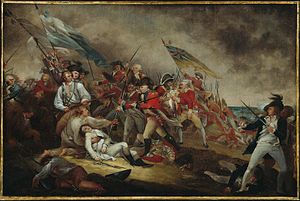Most of us remember learning about the Battle of Bunker Hill in our grade school history lessons. Do you remember the saying: “Don’t shoot until you see the whites of their eyes”? The Pyrrhic victory of the British early in the Revolutionary War. The fight in which the British took the hill outside of Boston from an under-armed and ill-trained force of rag-tag Colonials. Ring a bell?
Well, it turns out, this fight did not actually occur on Bunker Hill. The Battle of Bunker Hill in fact took place on the nearby Breed’s Hill. Shocking, right?
 I recently had the opportunity to travel to Boston and walk The Freedom Trail – a fascinating excursion that takes you on the path ridden by Paul Revere, the path marched by the troops fighting the battles of Lexington and Concord, and, yes, past Bunker Hill and Breed’s Hill. I’m not sure how this misnomer came about, but it’s true: most of the fighting of this crucial battle in fact occurred at the latter location.
I recently had the opportunity to travel to Boston and walk The Freedom Trail – a fascinating excursion that takes you on the path ridden by Paul Revere, the path marched by the troops fighting the battles of Lexington and Concord, and, yes, past Bunker Hill and Breed’s Hill. I’m not sure how this misnomer came about, but it’s true: most of the fighting of this crucial battle in fact occurred at the latter location.
Throughout the walk of The Freedom Trail, a couple of thoughts struck me. First, I was surprised to see how near these locations were to one another. True, the landscape was different back then: much of what we now think of as Boston was water during the Revolution, not filled in and built upon until centuries later. This of course made (what we call) Boston a much more fragmented patchwork of outposts and locations. Residents of and visitors to Boston nowadays can travel by car or subway in five minutes what it took days to travel on foot or horseback during the Revolutionary War. And still, it’s always an interesting exercise to wrap one’s head around the fact that we, as people with cars, routinely travel large distances that for the vast majority of human existence were prohibitively far apart. Paul Revere raced, Minute-men marched, and patriots gave their lives on a large swath of land that a morning commuter can easily travel while listening to a single song on an iPod and drinking just a few sips of coffee. It was interesting to be reminded of how small we are in relation to the land we live on, the history we walk through.
And second, I hadn’t expected these pivotal hills – these spikes of land on which the hopes of the nation were staked – to be, so, well, flat. These days, it’s possible to fly in several hours to the Rocky Mountains or the Grand Canyon. We can do a simple Google search and see what the Alps, the Himalayas, and even Mars look like. This had certainly skewed my way of thinking, rendering a small mound of earth like Bunker Hill, its monument jutting out like a needle, a little anti-climatic. It looked like a small mound of earth. And yet people fought for days, giving their lives, for that small mound of earth. I tried to wipe my imagination clean, to try to put myself in their shoes: skyscapers didn’t exist, and a church bell-tower was the highest structure piercing the top of an urban skyline. These hills provided the high vantage point around the city, and were thus integral pieces of land to occupy and defend.
American history is so rich, and I’m so appreciative of the fact that memorials like The Freedom Trail exist. For it’s one thing to read about a battle, it’s another to see the hill that was fought for. The hill that tested the mettle and resolve of the Colonial forces, showing that this rag-tag bunch of volunteers could in fact hold its own against the world’s most powerful and well-trained army. The Freedom Trails allows you to walk their walk, literally, even if some imagination is required to fill in the missing pieces. But hey, that’s the fun part.




